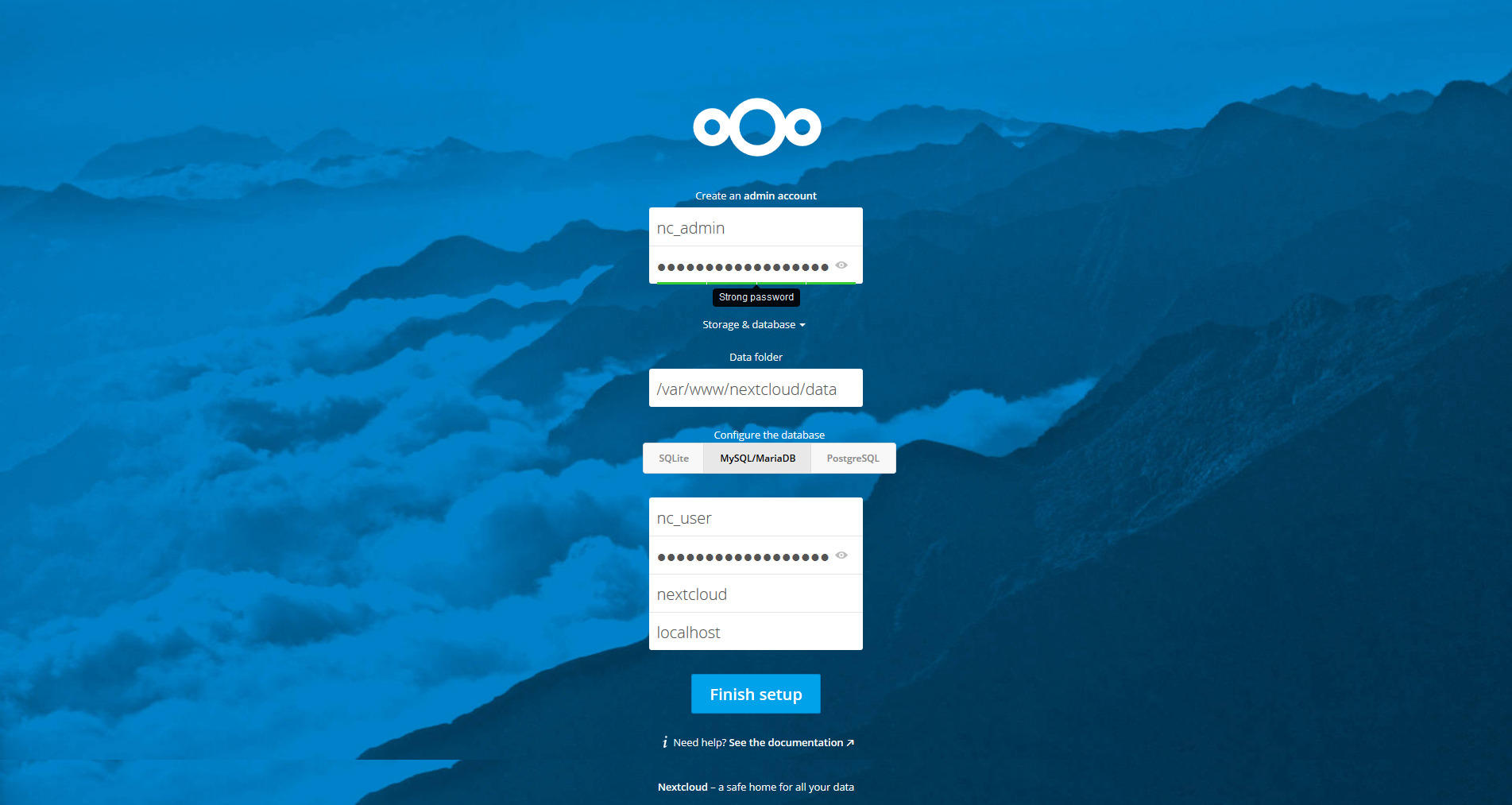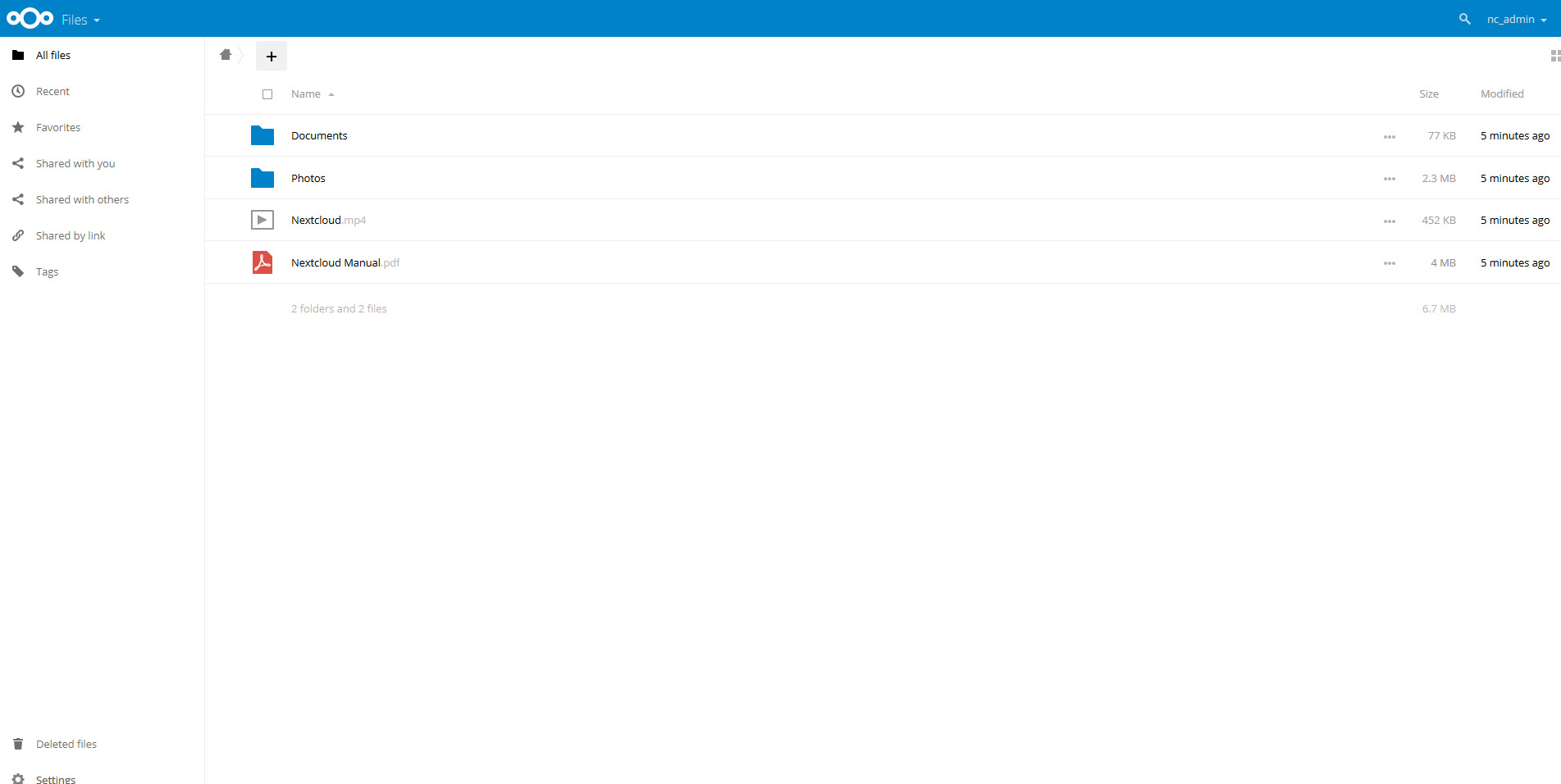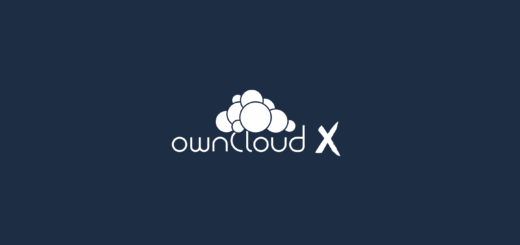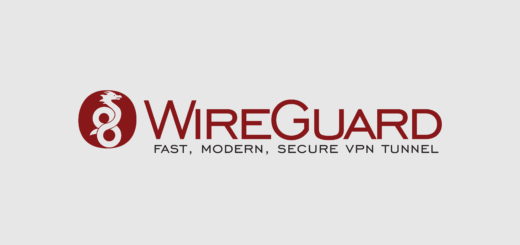NextCloud is a Dropbox-like solution for self-hosted file sharing and syncing. Installing NextCloud 11 on CentOS is quite simple. Whether you want to backup, have file-syncing or just have a Google Calendar alternative, this guide is for you.
Newer version!
There are newer versions of the software and newer versions of this guide available:
What is NextCloud? Is it like a “cloud”?
If you stumbled here by chance and don’t know what NextCloud is, here is an article explaining its principal features and advantages/disadvantages. To tell you the truth, NextCloud is a SaaS cloud, if you want to know more about cloud types you can read this article.
In this article we will cover the installation of the server (not the client).
Step1: Install software
Important
I take absolutely NO responsibility of what you do with your machine; use this tutorial as a guide and remember you can possibly cause data loss if you touch things carelessly.
The first step in order to install NextCloud 11 is to install a web server and PHP. Since CentOS 7 ships with PHP 5.4 by default but NextCloud 11 requires at least PHP 7 we’ll also be installing PHP 7.0 from a third-party repository. The following procedure will install apache as webserver. Input the commands one by one to avoid errors!
CentOS 7
If you’d rather use PHP 7.1, you can follow this tutorial: how to install PHP 7.1 on CentOS 7.
Warning!
If you decided to use PHP 7.1 rather than PHP 7.0 using the past tutorial, replace each instance of php70w with php71w in all the successive commands.
Open a terminal and input the following commands:
# yum install epel-release
# rpm -Uvh https://mirror.webtatic.com/yum/el7/webtatic-release.rpm
# yum install httpd php70w php70w-dom php70w-mbstring php70w-gd php70w-pdo php70w-json php70w-xml php70w-zip php70w-curl php70w-mcrypt php70w-pear setroubleshoot-server bzip2
# yum install epel-release
# rpm -Uvh https://mirror.webtatic.com/yum/el7/webtatic-release.rpm
# yum install httpd php70w php70w-dom php70w-mbstring php70w-gd php70w-pdo php70w-json php70w-xml php70w-zip php70w-curl php70w-mcrypt php70w-pear setroubleshoot-server bzip2
# yum install epel-release
# rpm -Uvh https://mirror.webtatic.com/yum/el7/webtatic-release.rpm
# yum install httpd php70w php70w-dom php70w-mbstring php70w-gd php70w-pdo php70w-json php70w-xml php70w-zip php70w-curl php70w-mcrypt php70w-pear setroubleshoot-server bzip2
Step 2: Database selection
Now that you got the software, you need to choose a database that will support the installation. You have three choices:
- SQLite: is a single-file database. It is suggested only for small installations since it will slow NextCloud down sensibly.
- MariaDB/MySQL: are popular open source databases especially amongst web developers. It is the suggested choice.
- PostgreSQL: a popular enterprise-class database. More complicated than MySQL/MariaDB.
Now, this choice won’t really alter the functionality of NextCloud (except if you use SQLite), so pick whatever you know best. If you’re unsure pick MariaDB/MySQL.
SQLiteMySQL/MariaDBPostgreSQL
No additional steps are required if you choose SQLite.
Install the software:
# yum install mariadb-server php70w-mysql
# yum install mariadb-server php70w-mysql
# yum install mariadb-server php70w-mysql
Start (and enable at boot) the service:
# systemctl start mariadb
# systemctl enable mariadb
# systemctl start mariadb
# systemctl enable mariadb
# systemctl start mariadb
# systemctl enable mariadb
Next step is to configure the database management system. During the configuration you will be prompted to choose a root password, pick a strong one.
# mysql_secure_installation
# mysql_secure_installation
# mysql_secure_installation
Now you need to enter the database (you will be asked the password you just set):
$ mysql -u root -p
Now that you are in create a database:
CREATE DATABASE nextcloud;
CREATE DATABASE nextcloud;
CREATE DATABASE nextcloud;
Now you need to create the user that will be used to connect to the database:
CREATE USER 'nc_user'@'localhost' IDENTIFIED BY 'YOUR_PASSWORD_HERE';
CREATE USER 'nc_user'@'localhost' IDENTIFIED BY 'YOUR_PASSWORD_HERE';
CREATE USER 'nc_user'@'localhost' IDENTIFIED BY 'YOUR_PASSWORD_HERE';
The last step is to grant the privileges to the new user:
GRANT ALL PRIVILEGES ON nextcloud.* TO 'nc_user'@'localhost';
GRANT ALL PRIVILEGES ON nextcloud.* TO 'nc_user'@'localhost';
FLUSH PRIVILEGES;
GRANT ALL PRIVILEGES ON nextcloud.* TO 'nc_user'@'localhost';
FLUSH PRIVILEGES;
When you’re done type Ctrl-D to exit.
Install the software:
# yum install postgresql postgresql-server php70w-pgsql
# yum install postgresql postgresql-server php70w-pgsql
# yum install postgresql postgresql-server php70w-pgsql
Run the setup:
# postgresql-setup initdb
# postgresql-setup initdb
# postgresql-setup initdb
Start (and enable at boot) the service:
# systemctl start postgresql
# systemctl enable postgresql
# systemctl start postgresql
# systemctl enable postgresql
# systemctl start postgresql
# systemctl enable postgresql
Now you need to enter the database:
$ sudo -u postgres psql
Now that you are in create a database:
CREATE DATABASE nextcloud;
CREATE DATABASE nextcloud;
CREATE DATABASE nextcloud;
Now you need to create the user that will be used to connect to the database:
CREATE USER nc_user WITH PASSWORD 'YOUR_PASSWORD_HERE';
CREATE USER nc_user WITH PASSWORD 'YOUR_PASSWORD_HERE';
CREATE USER nc_user WITH PASSWORD 'YOUR_PASSWORD_HERE';
The last step is to grant the privileges to the new user:
GRANT ALL PRIVILEGES ON DATABASE nextcloud to nc_user;
GRANT ALL PRIVILEGES ON DATABASE nextcloud to nc_user;
GRANT ALL PRIVILEGES ON DATABASE nextcloud to nc_user;
When you’re done type \q and press enter to exit.
Warning: You may experience difficulties in authenticating NextCloud with PostgreSQL since the local authentication method is set to ident by default. If you want to change it keep reading.
The configuration file for PostgreSQL is a file located in /var/lib/pgsql/data/pg_hba.conf . Open it with your favourite editor and look for the marked line:
# TYPE DATABASE USER ADDRESS METHOD
# "local" is for Unix domain socket connections only
# IPv4 local connections:
host all all 127.0.0.1/32 ident
# IPv6 local connections:
host all all ::1/128 ident
# Allow replication connections from localhost, by a user with the
#local replication postgres peer
#host replication postgres 127.0.0.1/32 ident
#host replication postgres ::1/128 ident
# TYPE DATABASE USER ADDRESS METHOD
# "local" is for Unix domain socket connections only
local all all peer
# IPv4 local connections:
host all all 127.0.0.1/32 ident
# IPv6 local connections:
host all all ::1/128 ident
# Allow replication connections from localhost, by a user with the
# replication privilege.
#local replication postgres peer
#host replication postgres 127.0.0.1/32 ident
#host replication postgres ::1/128 ident
# TYPE DATABASE USER ADDRESS METHOD
# "local" is for Unix domain socket connections only
local all all peer
# IPv4 local connections:
host all all 127.0.0.1/32 ident
# IPv6 local connections:
host all all ::1/128 ident
# Allow replication connections from localhost, by a user with the
# replication privilege.
#local replication postgres peer
#host replication postgres 127.0.0.1/32 ident
#host replication postgres ::1/128 ident
Replace ident with md5 on that line and restart PostgreSQL:
# systemctl restart postgresql
# systemctl restart postgresql
# systemctl restart postgresql
At this point, if you selected MySQL/MariaDB or PostgreSQL restart the webserver in order to load the new PHP extension:
# systemctl restart httpd
# systemctl restart httpd
# systemctl restart httpd
Step 3: Install NextCloud
This step involves getting the software and configure Apache to run it.
CentOS 7
With these step we download the software and extract it:
# curl -o nextcloud-11-latest.tar.bz2 https://download.nextcloud.com/server/releases/latest-11.tar.bz2
# tar -xvjf nextcloud-11-latest.tar.bz2
# chown -R apache:apache nextcloud
# rm nextcloud-11-latest.tar.bz2
# cd /var/www/html
# curl -o nextcloud-11-latest.tar.bz2 https://download.nextcloud.com/server/releases/latest-11.tar.bz2
# tar -xvjf nextcloud-11-latest.tar.bz2
# mkdir nextcloud/data
# chown -R apache:apache nextcloud
# rm nextcloud-11-latest.tar.bz2
# cd /var/www/html
# curl -o nextcloud-11-latest.tar.bz2 https://download.nextcloud.com/server/releases/latest-11.tar.bz2
# tar -xvjf nextcloud-11-latest.tar.bz2
# mkdir nextcloud/data
# chown -R apache:apache nextcloud
# rm nextcloud-11-latest.tar.bz2
Now we need to create a new file in /etc/httpd/conf.d/nextcloud.conf . Feel free to use whatever editor you feel comfortable with and add the following lines:
Alias /nextcloud "/var/www/html/nextcloud/"
<Directory /var/www/html/nextcloud/>
SetEnv HOME /var/www/html/nextcloud
SetEnv HTTP_HOME /var/www/html/nextcloud
Alias /nextcloud "/var/www/html/nextcloud/"
<Directory /var/www/html/nextcloud/>
Options +FollowSymlinks
AllowOverride All
<IfModule mod_dav.c>
Dav off
</IfModule>
SetEnv HOME /var/www/html/nextcloud
SetEnv HTTP_HOME /var/www/html/nextcloud
</Directory>
Alias /nextcloud "/var/www/html/nextcloud/"
<Directory /var/www/html/nextcloud/>
Options +FollowSymlinks
AllowOverride All
<IfModule mod_dav.c>
Dav off
</IfModule>
SetEnv HOME /var/www/html/nextcloud
SetEnv HTTP_HOME /var/www/html/nextcloud
</Directory>
Step 4: Setting Apache and SELinux
In this step we’ll start (and enable) the webserver and we’ll set SELinux up. Now, many tutorials will tell you to disable SELinux (because it is a difficult component to manage). Instead, I suggest you to keep it on and add the rules for NextCloud:
# semanage fcontext -a -t httpd_sys_rw_content_t '/var/www/html/nextcloud/data(/.*)?'
# semanage fcontext -a -t httpd_sys_rw_content_t '/var/www/html/nextcloud/config(/.*)?'
# semanage fcontext -a -t httpd_sys_rw_content_t '/var/www/html/nextcloud/apps(/.*)?'
# semanage fcontext -a -t httpd_sys_rw_content_t '/var/www/html/nextcloud/.htaccess'
# semanage fcontext -a -t httpd_sys_rw_content_t '/var/www/html/nextcloud/.user.ini'
# restorecon -Rv '/var/www/html/nextcloud/'
# semanage fcontext -a -t httpd_sys_rw_content_t '/var/www/html/nextcloud/data(/.*)?'
# semanage fcontext -a -t httpd_sys_rw_content_t '/var/www/html/nextcloud/config(/.*)?'
# semanage fcontext -a -t httpd_sys_rw_content_t '/var/www/html/nextcloud/apps(/.*)?'
# semanage fcontext -a -t httpd_sys_rw_content_t '/var/www/html/nextcloud/.htaccess'
# semanage fcontext -a -t httpd_sys_rw_content_t '/var/www/html/nextcloud/.user.ini'
# restorecon -Rv '/var/www/html/nextcloud/'
# semanage fcontext -a -t httpd_sys_rw_content_t '/var/www/html/nextcloud/data(/.*)?'
# semanage fcontext -a -t httpd_sys_rw_content_t '/var/www/html/nextcloud/config(/.*)?'
# semanage fcontext -a -t httpd_sys_rw_content_t '/var/www/html/nextcloud/apps(/.*)?'
# semanage fcontext -a -t httpd_sys_rw_content_t '/var/www/html/nextcloud/.htaccess'
# semanage fcontext -a -t httpd_sys_rw_content_t '/var/www/html/nextcloud/.user.ini'
# restorecon -Rv '/var/www/html/nextcloud/'
If you decided to use a Mariadb/MySQL/PostgreSQL, you also need to allow apache to access it:
# setsebool -P httpd_can_network_connect_db 1
# setsebool -P httpd_can_network_connect_db 1
# setsebool -P httpd_can_network_connect_db 1
Now that you’ve configured SELinux let’s start and enable Apache:
CentOS 7
Start (and enable at boot) the service:
# systemctl start httpd
# systemctl enable httpd
# systemctl start httpd
# systemctl enable httpd
Step 5: Configuring firewall
This step is essential when your firewall is enabled. If your firewall is enabled you won’t be able to access your NextCloud 11 instance; on the other hand if it isn’t enabled you shouldn’t have any problems and you can simply skip this step.
Tip!
Keep in mind having a firewall enabled is a good security practice and you should already have one enabled.
In order for the firewall to work, it must be enabled. This guide will not include this part. When you enable a firewall many things can go wrong, e.g. you’re using SSH, you enable the firewall and your connection is cut and can’t connect otherwise, hence you should carefully review the documentation from your distribution.
To open the ports needed by NextCloud 11 follow these steps:
FirewallDIPtables
FirewallD is a newer firewall used to simplify firewall management. If you’re using it you can simply do:
# firewall-cmd --add-service http --permanent
# firewall-cmd --add-service https --permanent
# firewall-cmd --add-service http --permanent
# firewall-cmd --add-service https --permanent
# firewall-cmd --reload
# firewall-cmd --add-service http --permanent
# firewall-cmd --add-service https --permanent
# firewall-cmd --reload
IPtables is an older firewall (still widely used), if you have disabled firewallD you can use IPtables directly.
# iptables -A INPUT -p tcp -m tcp --dport 80 -j ACCEPT
# iptables -A INPUT -p tcp -m tcp --dport 443 -j ACCEPT
# iptables -A INPUT -p tcp -m tcp --dport 80 -j ACCEPT
# iptables -A INPUT -p tcp -m tcp --dport 443 -j ACCEPT
# iptables -A INPUT -p tcp -m tcp --dport 80 -j ACCEPT
# iptables -A INPUT -p tcp -m tcp --dport 443 -j ACCEPT
Step 6: Install
Once you’re done with selecting the database, it’s time to install everything. Head to http://YOUR_IP_ADDRESS/nextcloud/ and you will be facing the following screen:

Nextcloud 11 Installation
Select an administrator username and password, then you can select the data folder, but if you don’t know what you’re doing it’s best if you leave it with the default value. Then click on “Storage & Database” to select the database you chose during step 2. Fill everything and if you’ve followed all the steps correctly you should be seeing the Files app:

Nextcloud 11 Files
The IT guy with a slight look of boredom in his eyes. Freelancer. Current interests: Kubernetes, Tensorflow, shiny new things.












Nice clear instructions. You may want to include firewall commands (just for completeness… and change hmtl to html… took me a minute to find what was wrong :)
Hello Michiel,
thank you for your contribution, I’m fixing the html typo right away. About the firewall, I could include it for reference, I initially excluded it to protect newbie users. Experienced users should be able to configure their distribution firewall without problems.